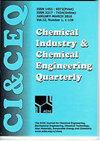热安全约束下管式反应器低密度聚乙烯生产的动态优化
IF 0.8
4区 工程技术
Q4 CHEMISTRY, APPLIED
Chemical Industry & Chemical Engineering Quarterly
Pub Date : 2021-01-01
DOI:10.2298/ciceq190108027a
引用次数: 7
摘要
低密度聚乙烯(LDPE)是一种在长管式反应器中由乙烯在引发剂存在下聚合而成的工业用低密度聚乙烯(LDPE),在聚合物工业中应用最为广泛。LDPE聚合过程的高度放热性质和管式反应器中的加热-冷却先决条件会导致各种问题,特别是在热失控和生产率方面的安全性,即单体转化率的降低。因此,需要对考虑热安全的工业LDPE管式反应器进行基于模型的优化。开发了该过程的第一原理模型,并使用工业数据进行了验证。从LDPE聚合动力学中得到了质量和能量平衡。在此基础上,建立了临界工况下的反应堆温度表达式,并将其纳入热安全研究的参考模型。为了保证工艺的热安全性和满足期望的产品等级,提出了采用正交配置法实现单体转化率最大化的约束动态优化方法。动态优化结果表明,通过优化反应器夹套可以满足临界条件约束下的最高反应温度。此外,它是在不损害单体转化和产品等级的情况下实现的。本文章由计算机程序翻译,如有差异,请以英文原文为准。
Dynamic optimization of low-density polyethylene production in tubular reactor under thermal safety constraint
A commercial low-density polyethylene (LDPE) which is produced by the polymerization process of ethylene in the presence of initiators in a long tubular reactor is the most widely used in polymer industry. The highly exothermic nature of the LDPE polymerization process and the heating-cooling prerequisite in the tubular reactor can lead to various problems, particularly safety in terms of thermal runaway and productivity, i.e., decreasing monomer conversion. Therefore, model-based optimization of an industrial LDPE tubular reactor under thermal safety consideration is required to be implemented. A first principle model for this process is developed and validated using industrial data. Mass and energy balances have been derived from kinetics of LDPE polymerization. Thereafter, an expression of reactor temperature under critical condition is developed and incorporated in the reference model for the thermal safety study. In order to ensure the process is thermally safe and meets the desired product grade, the constrained dynamic optimization is proposed to maximize the conversion of the monomer using orthogonal collocation (OC). The dynamic optimization result shows that the maximum reaction temperature under critical condition constraint can be satisfied by optimizing the reactor jacket. Moreover, it is achieved without jeopardizing the monomer conversion and the product grade.
求助全文
通过发布文献求助,成功后即可免费获取论文全文。
去求助
来源期刊

Chemical Industry & Chemical Engineering Quarterly
CHEMISTRY, APPLIED-ENGINEERING, CHEMICAL
CiteScore
2.10
自引率
0.00%
发文量
24
审稿时长
3.3 months
期刊介绍:
The Journal invites contributions to the following two main areas:
• Applied Chemistry dealing with the application of basic chemical sciences to industry
• Chemical Engineering dealing with the chemical and biochemical conversion of raw materials into different products as well as the design and operation of plants and equipment.
The Journal welcomes contributions focused on:
Chemical and Biochemical Engineering [...]
Process Systems Engineering[...]
Environmental Chemical and Process Engineering[...]
Materials Synthesis and Processing[...]
Food and Bioproducts Processing[...]
Process Technology[...]
 求助内容:
求助内容: 应助结果提醒方式:
应助结果提醒方式:


